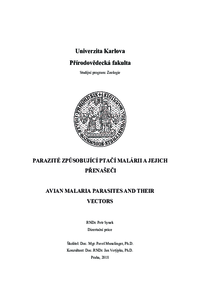Parazité způsobující ptačí malárii a jejich přenašeči
Avian malaria parasites and their vectors
dizertační práce (OBHÁJENO)

Zobrazit/
Trvalý odkaz
http://hdl.handle.net/20.500.11956/99748Identifikátory
SIS: 83763
Kolekce
- Kvalifikační práce [19614]
Autor
Vedoucí práce
Konzultant práce
Votýpka, Jan
Oponent práce
Hypša, Václav
Široký, Pavel.
Fakulta / součást
Přírodovědecká fakulta
Obor
-
Katedra / ústav / klinika
Katedra zoologie
Datum obhajoby
22. 6. 2018
Nakladatel
Univerzita Karlova, Přírodovědecká fakultaJazyk
Čeština
Známka
Prospěl/a
Klíčová slova (česky)
malárie, Plasmodium, HaemoproteusKlíčová slova (anglicky)
malaria, Plasmodium, HaemoproteusParazity způsobující ptačí malárii řadíme mezi Haemosporida, která představují monofyletickou skupinu dixenních protist patřících do kmene Apicomplexa. Jejich nepohlavní množení probíhá v obratlovčím mezihostiteli a ke vzniku gamet a sporogonii dochází v krevsajícím dvoukřídlém hmyzu, který je tudíž konečným hostitelem těchto parazitů. U ptáku jako mezihostitelů se setkáváme s následujícími třemi rody těchto parazitů: Plasmodium, Haemoproteus a Leucocytozoon. V disertační práci jsem se soustředil na Haemosporida volně žijících ptáků a na způsob jejich přenosu hmyzími vektory v přírodních populacích, což byla prozatím opomíjená oblast výzkumu zaměřeného na původce ptačí malárii. Výsledky byly získány jak tradičními metodami (vyšetření infekcí pomocí mikroskopování krevních roztěrů), tak především molekulárně biologickými metodami (detekcí parazitů pomocí nested PCR) založenými na práci s unikátními haplotypy jednotlivých linií haemosporid. Cílem studie bylo určit okruh možných přenašečů ptačích haemosporid na území České republiky s přihlédnutím ke specificitě ptačích haemosporid v rámci těchto vektorů a popsat diverzitu ptačích haemosporid v populacích jejich ptačích mezihostitelů. K tomu jsme si vybrali čtyři různé druhy ptáků, patřících do čtyř řádů (pěvci - Passeriformes, sovy -...
Parasites causing avian malaria belong to the group Haemosporida, which represents a monophyletic group of dixenic protists within Apicomplexa. Their asexual reproduction takes place in a vertebrate intermediate host, and the formation of gametes and sporogony occur in blood-sucking dipteran insects, which are the definitive hosts of these parasites. Three main genera (Plasmodium, Haemoproteus and Leucocytozoon) are found mostly in their avian hosts. We focused on the Haemosporida of wild birds and their transmission by insect vectors in natural populations, which had previously been a neglected area. Our results were obtained both by traditional methods (investigation of infections by microscopy of blood smears) and mainly by molecular methods (e.g. nested PCR) centered around work with unique haplotypes of the haemosporid lineages. The aim of our work was to determine the range of possible insect vectors of avian haemosporidians in the territory of the Czech Republic, taking into account the specificity of the parasites within these vectors, and to describe the diversity of haemosporidians in the populations of their bird intermediate hosts. We chose four different species of birds from four orders (Passeriformes, Strigiformes, Accipitriformes, and Galliformes). As potential vectors of avian...
